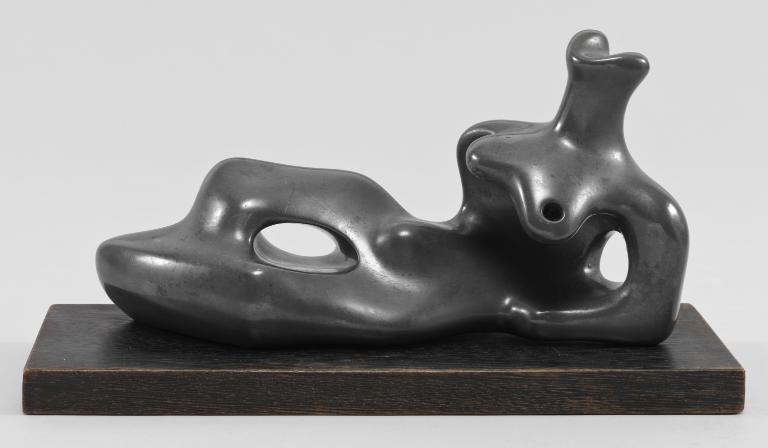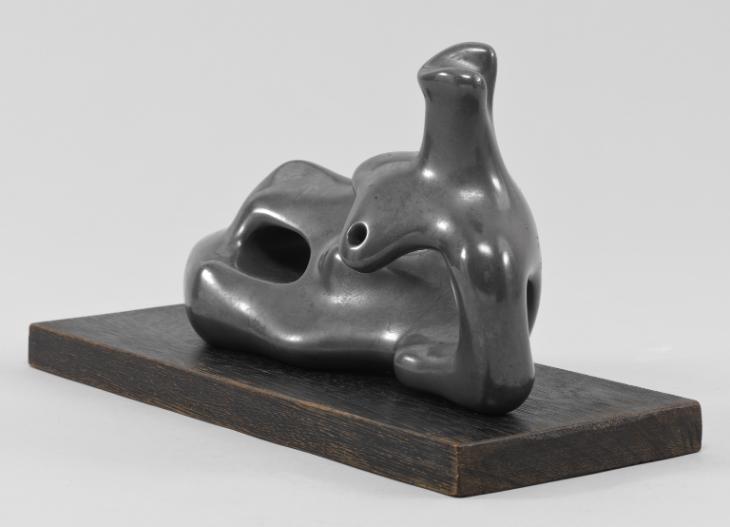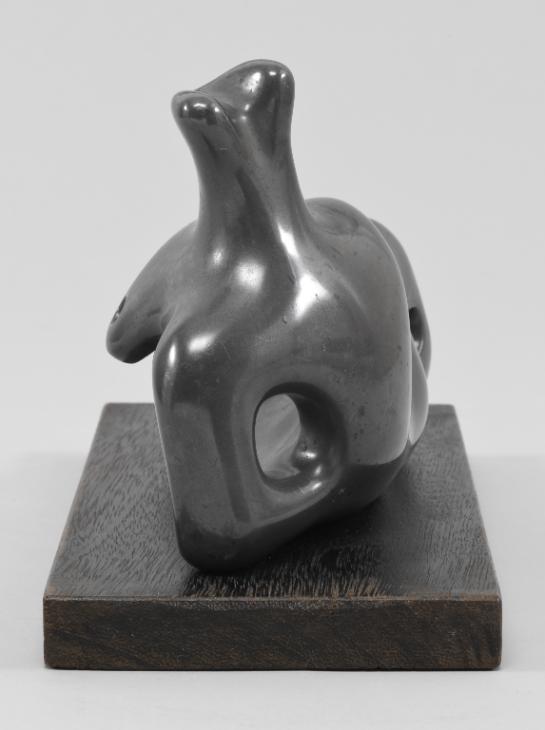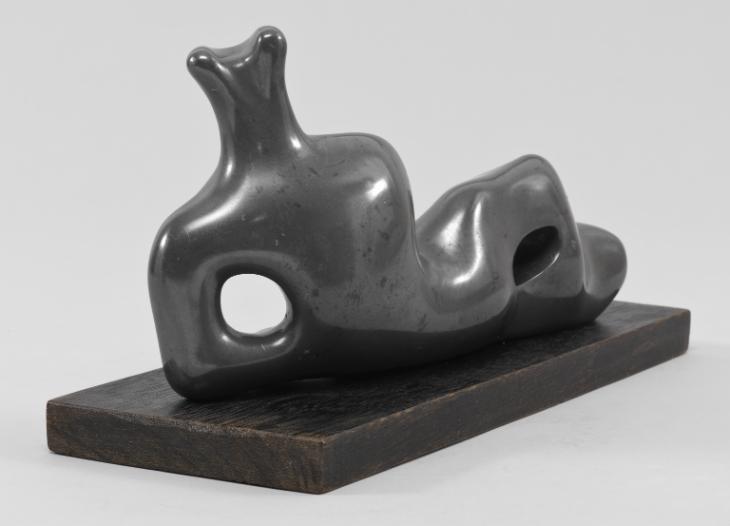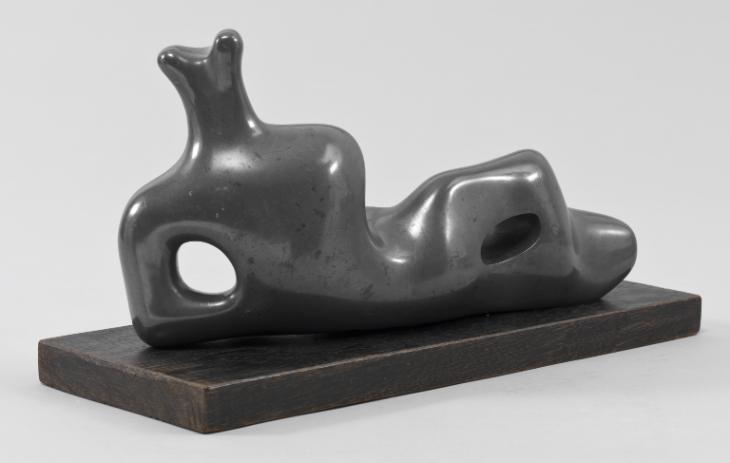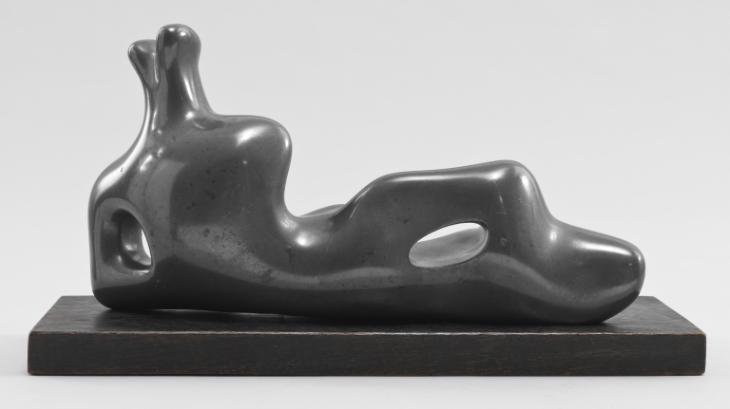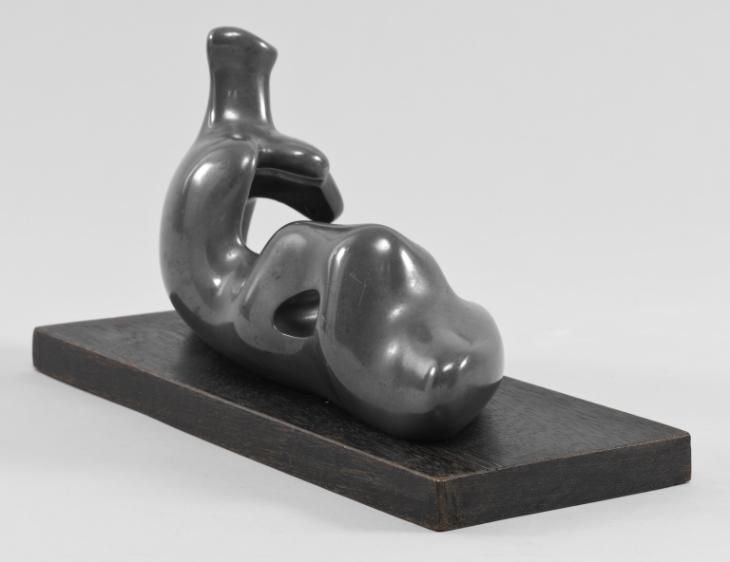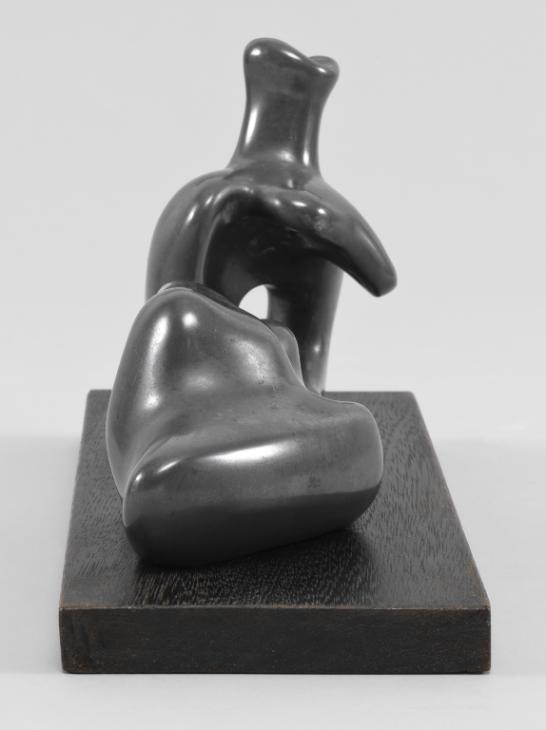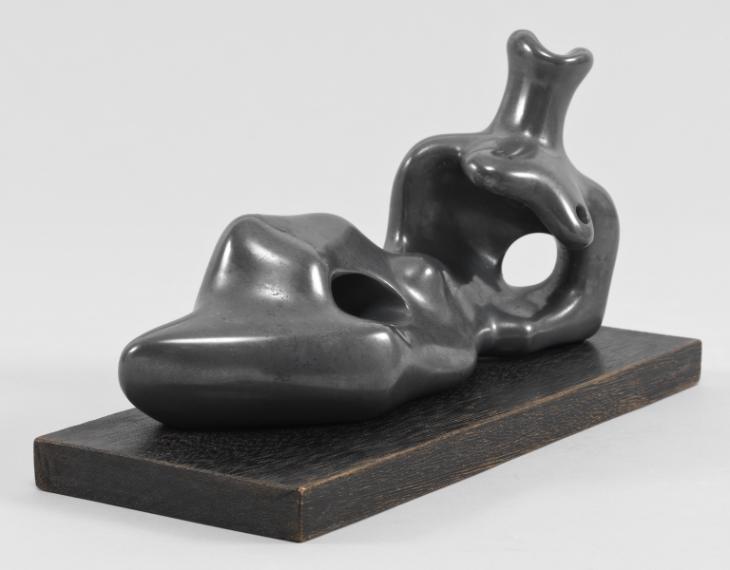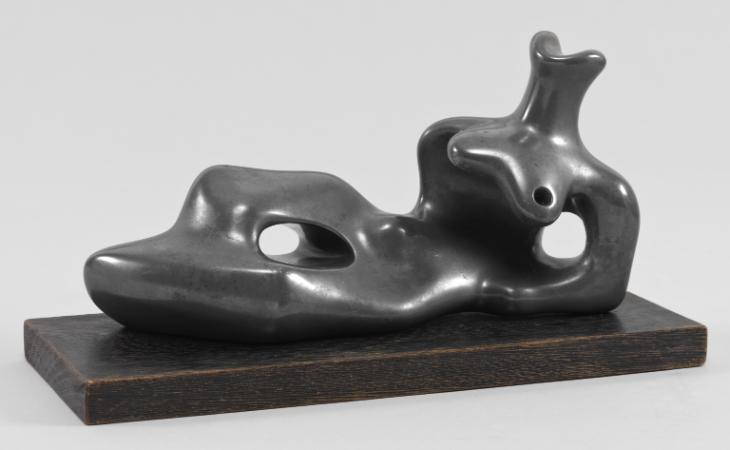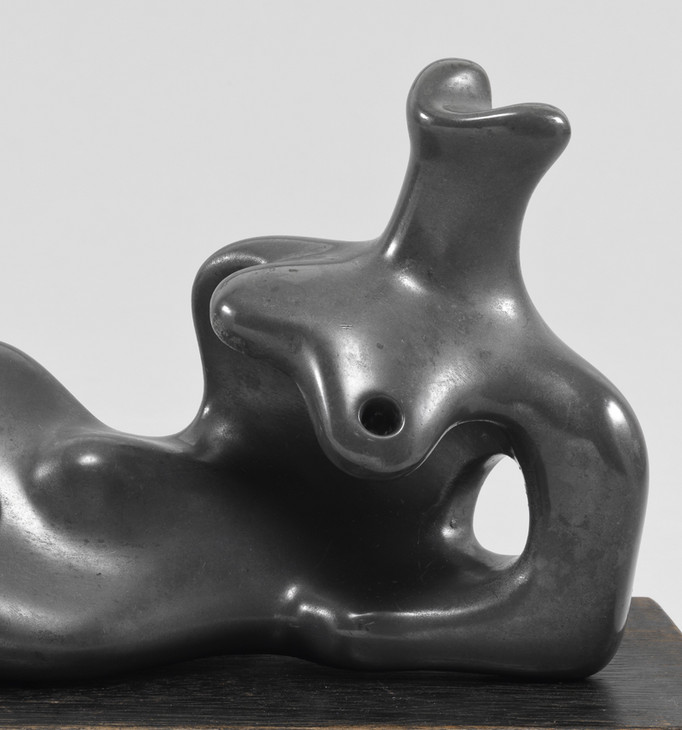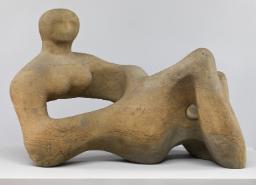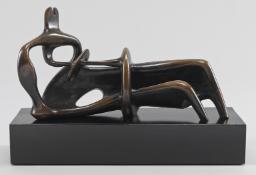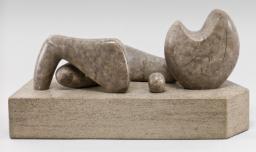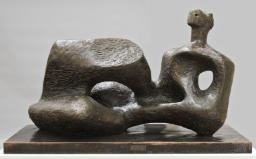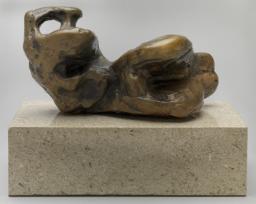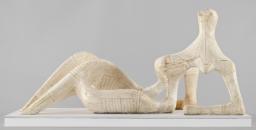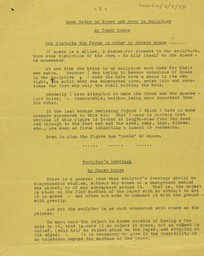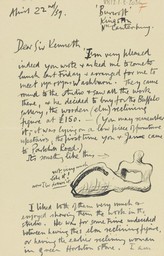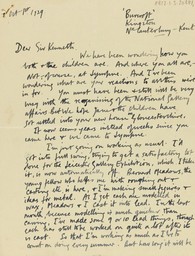Henry Moore OM, CH Reclining Figure 1939
Image 1 of 11
-
 Henry Moore OM, CH, Reclining Figure 1939© The Henry Moore Foundation. All Rights Reserved© The Henry Moore Foundation. All Rights Reserved
Henry Moore OM, CH, Reclining Figure 1939© The Henry Moore Foundation. All Rights Reserved© The Henry Moore Foundation. All Rights Reserved -
 Henry Moore OM, CH, Reclining Figure 1939© The Henry Moore Foundation. All Rights Reserved© The Henry Moore Foundation. All Rights Reserved
Henry Moore OM, CH, Reclining Figure 1939© The Henry Moore Foundation. All Rights Reserved© The Henry Moore Foundation. All Rights Reserved -
 Henry Moore OM, CH, Reclining Figure 1939© The Henry Moore Foundation. All Rights Reserved© The Henry Moore Foundation. All Rights Reserved
Henry Moore OM, CH, Reclining Figure 1939© The Henry Moore Foundation. All Rights Reserved© The Henry Moore Foundation. All Rights Reserved -
 Henry Moore OM, CH, Reclining Figure 1939© The Henry Moore Foundation. All Rights Reserved© The Henry Moore Foundation. All Rights Reserved
Henry Moore OM, CH, Reclining Figure 1939© The Henry Moore Foundation. All Rights Reserved© The Henry Moore Foundation. All Rights Reserved -
 Henry Moore OM, CH, Reclining Figure 1939© The Henry Moore Foundation. All Rights Reserved© The Henry Moore Foundation. All Rights Reserved
Henry Moore OM, CH, Reclining Figure 1939© The Henry Moore Foundation. All Rights Reserved© The Henry Moore Foundation. All Rights Reserved -
 Henry Moore OM, CH, Reclining Figure 1939© The Henry Moore Foundation. All Rights Reserved© The Henry Moore Foundation. All Rights Reserved
Henry Moore OM, CH, Reclining Figure 1939© The Henry Moore Foundation. All Rights Reserved© The Henry Moore Foundation. All Rights Reserved -
 Henry Moore OM, CH, Reclining Figure 1939© The Henry Moore Foundation. All Rights Reserved© The Henry Moore Foundation. All Rights Reserved
Henry Moore OM, CH, Reclining Figure 1939© The Henry Moore Foundation. All Rights Reserved© The Henry Moore Foundation. All Rights Reserved -
 Henry Moore OM, CH, Reclining Figure 1939© The Henry Moore Foundation. All Rights Reserved© The Henry Moore Foundation. All Rights Reserved
Henry Moore OM, CH, Reclining Figure 1939© The Henry Moore Foundation. All Rights Reserved© The Henry Moore Foundation. All Rights Reserved -
 Henry Moore OM, CH, Reclining Figure 1939© The Henry Moore Foundation. All Rights Reserved© The Henry Moore Foundation. All Rights Reserved
Henry Moore OM, CH, Reclining Figure 1939© The Henry Moore Foundation. All Rights Reserved© The Henry Moore Foundation. All Rights Reserved -
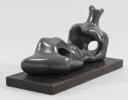 Henry Moore OM, CH, Reclining Figure 1939© The Henry Moore Foundation. All Rights Reserved© The Henry Moore Foundation. All Rights Reserved
Henry Moore OM, CH, Reclining Figure 1939© The Henry Moore Foundation. All Rights Reserved© The Henry Moore Foundation. All Rights Reserved -
 Henry Moore OM, CH, Reclining Figure 1939© The Henry Moore Foundation. All Rights Reserved© The Henry Moore Foundation. All Rights Reserved
Henry Moore OM, CH, Reclining Figure 1939© The Henry Moore Foundation. All Rights Reserved© The Henry Moore Foundation. All Rights Reserved
© The Henry Moore Foundation. All Rights Reserved
Henry Moore OM, CH,
Reclining Figure
1939
© The Henry Moore Foundation. All Rights Reserved
Made at Henry Moore’s home in Kent, Reclining Figure is an example of the artist’s experiments with lead casting in the late 1930s. Its molten, rounded forms testify to Moore’s interest in organic shapes and the sculptures of Jean Arp, while drawings relating to this work reveal that Moore imagined enlarging it and positioning it within a natural landscape.
Henry Moore OM, CH 1898–1986
Reclining Figure
1939
Lead on oak base
150 x 280 x 100 mm
Purchased through the Leicester Galleries by the Victoria & Albert Museum in 1940; transferred to the Tate Gallery 1983
Lead cast aside from edition of 4 bronze casts
T03761
Reclining Figure
1939
Lead on oak base
150 x 280 x 100 mm
Purchased through the Leicester Galleries by the Victoria & Albert Museum in 1940; transferred to the Tate Gallery 1983
Lead cast aside from edition of 4 bronze casts
T03761
Ownership history
Purchased from the artist through the Leicester Galleries, London, by the Victoria & Albert Museum in 1940; transferred to the Tate Gallery 1983.
Exhibition history
1940
Henry Moore: New Sculpture and Drawings, Leicester Galleries, London, February 1940, no.74 (as ‘Reclining Figure in Lead’).
1946–7
Henry Moore, Museum of Modern Art, New York, December 1946–March 1947; Art Institute of Chicago, Chicago, April–May 1947; San Francisco Museum of Art, San Francisco, July–August 1947, no.44.
1951
Sculpture and Drawings by Henry Moore, Tate Gallery, London, May–July 1951, no.110.
1968
Henry Moore, Tate Gallery, July–September 1968, no.46.
1974
Art Then: Eight English Artists, 1924–40, Scottish Arts Council Gallery, Edinburgh, August–September 1974, no.22.
1979–80
Thirties: British Art and Design Before the War, Hayward Gallery, London, October 1979–January 1980, no.56.
1998
Special Exhibition: Henry Moore, Imperial War Museum, London, September–November 1998.
2010–11
Henry Moore, Tate Britain, London, February–August 2010; Art Gallery of Ontario, Toronto, October 2010–February 2011; Leeds Art Gallery, Leeds, March–June 2011, no.84.
2012
Henry Moore at the Kremlin, Moscow Kremlin Museum, Moscow, February–May 2012.
References
1944
Herbert Read (ed.), Henry Moore: Sculpture and Drawings, London 1944, reproduced pl.102.
1947
Leigh Ashton, Style in Sculpture, London 1947, p.58, reproduced pl.38.
1948
Henry Moore, exhibition catalogue, British Pavilion, Venice Biennale, Venice 1948, unpaginated, reproduced.
1951
David Sylvester (ed.), Sculpture and Drawings by Henry Moore, exhibition catalogue, Tate Gallery, London 1951, unpaginated.
1957
David Sylvester (ed.), Henry Moore. Volume 1: Complete Sculpture 1921–48, London 1957, no.202, reproduced p.117.
1960
Will Grohmann, The Art of Henry Moore, London 1960, pp.46–8, (?bronze cast reproduced pl.33).
1961
Henry Moore, exhibition catalogue, Musée Rodin, Paris 1961 (bronze cast reproduced pl.6).
1968
David Sylvester, Henry Moore, exhibition catalogue, Tate Gallery, London 1968, p.171.
1970
Robert Melville, Henry Moore: Sculpture and Drawings 1921–69, London 1970, (?bronze cast reproduced fig.217).
1979
Alan G. Wilkinson, The Moore Collection in the Art Gallery of Ontario, Toronto 1979, p.202 (bronze cast reproduced pl.180).
1984
Henry Moore: The Reclining Figure, exhibition catalogue, Columbus Museum of Art, Columbus 1984, reproduced p.42.
1988
[Judith Collins], ‘Henry Moore: Reclining Figure 1939’, in The Tate Gallery 1984–86: Illustrated Catalogue of Acquisitions Including Supplement to Catalogue of Acquisitions 1982–84, London 1988, pp.538–40.
2001
Dorothy Kosinski (ed.), Henry Moore: Sculpting the 20th Century, exhibition catalogue, Dallas Museum of Art, Dallas 2001 (bronze cast reproduced p.134).
2004
Henry Moore at Dulwich Picture Gallery, exhibition catalogue, Dulwich Picture Gallery, London 2004 (bronze cast reproduced p.75).
2006
Terry Friedman, ‘Reclining Figure 1939’, in David Mitchinson (ed.), Celebrating Moore: Works from the Collection of the Henry Moore Foundation, London 2006, pp.177–8 (bronze cast reproduced p.117).
2010
Mary Moore, ‘Reclining Figure 1939’, in Gregor Muir (ed.), Henry Moore: Ideas for Sculpture, exhibition catalogue, Hauser & Wirth, London 2010, p.137 (bronze cast reproduced pp.135–6).
2010
Chris Stephens (ed.), Henry Moore, exhibition catalogue, Tate Britain, London 2010, reproduced p.157.
Technique and condition
This small reclining figure is cast in lead and mounted on a flat rectangular oak base that is stained black. It is possible that Henry Moore cast this sculpture himself without the involvement of a foundry, as it is known that he cast several lead figures at his home around the time this sculpture was made. Prior to casting Moore would have made an original model, probably using wax, from which the lead sculpture was cast.
The surface of the sculpture is very smooth and there are few marks that provide evidence of what casting technique was used. However, it is likely that a sculpture of this size would have been cast using the traditional lost wax technique. Moore would have worked the surface of the metal after casting using files and sandpaper in increasingly fine grades to achieve the polished finish. A clear wax is visible on the surface, which enhances the shine but also protects the lead against finger marks and corrosion. There are some circular outlines on the lead surface that show the formation of a slightly different crystalline structure in the metal as the lead in these areas cooled at a different rate from the rest of the cast (fig.1). No inscription is visible on the surface of the sculpture. Some scratches are evident and a Tate conservation report written in 2004 suggests that these may be historical.1
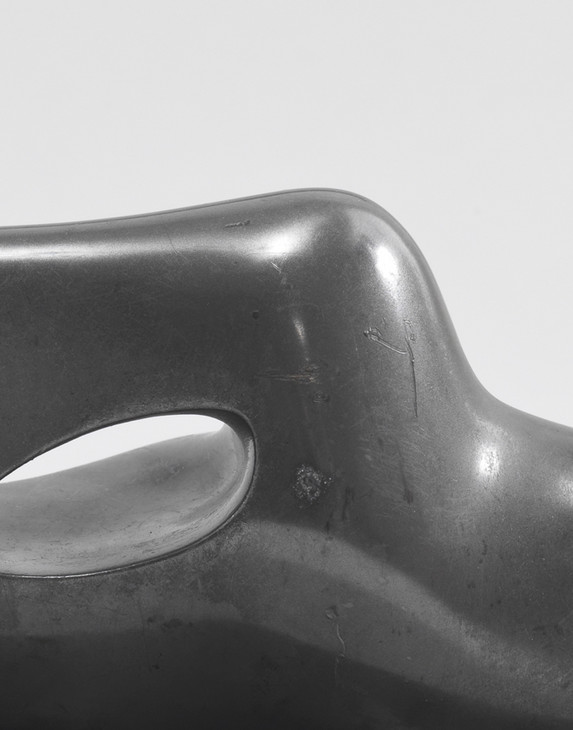
Detail of Reclining Figure 1939 showing formation of crystalline structure and scratches
Tate T03761
© The Henry Moore Foundation. All Rights Reserved
Fig.1
Detail of Reclining Figure 1939 showing formation of crystalline structure and scratches
Tate T03761
© The Henry Moore Foundation. All Rights Reserved
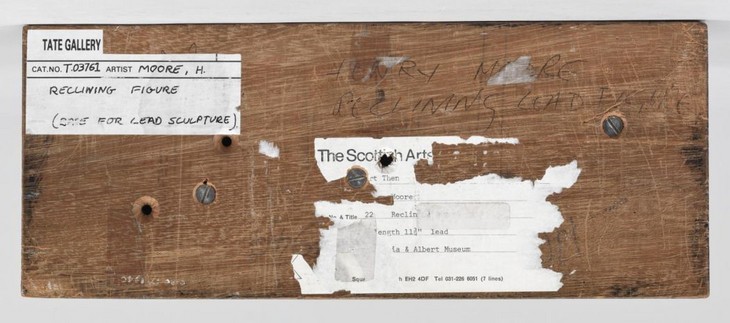
Underside of base of Reclining Figure 1939
Tate T03761
© The Henry Moore Foundation. All Rights Reserved All Rights Reserved, DACS 2015
Fig.2
Underside of base of Reclining Figure 1939
Tate T03761
© The Henry Moore Foundation. All Rights Reserved All Rights Reserved, DACS 2015
The sculpture is fixed to its base with three recessed screws that pass through the base from underneath (fig.2). Three other holes are visible in the base in different positions which may indicate that this was a base intended originally for another work, or that the fixing locations were altered.
Lyndsey Morgan
October 2011
Notes
How to cite
Lyndsey Morgan, 'Technique and Condition', October 2011, in Alice Correia, ‘Reclining Figure 1939 by Henry Moore OM, CH’, catalogue entry, January 2013, in Henry Moore: Sculptural Process and Public Identity, Tate Research Publication, 2015, https://wwwEntry
This sculpture presents a reclining female figure propped up on her left elbow. The figure’s head and torso form a vertical axis that contrasts with the horizontal axis created by her legs, which stretch out to the left. While the outlines of individual limbs are identifiable, various parts of the body are conjoined within the singular form as though they had melted into each other. This effect is heightened by the colour and surface sheen of the lead, which give the impression that the sculpture might be soft to touch.
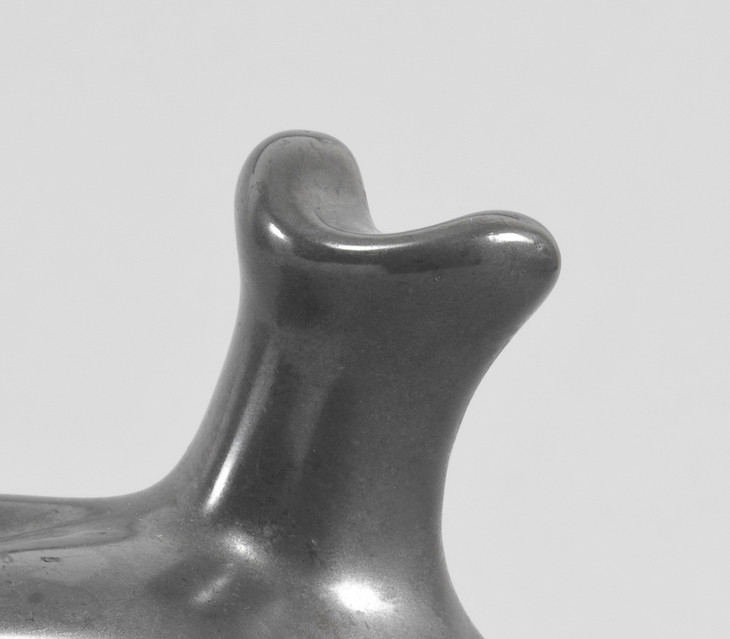
Detail of head of Reclining Figure 1939
Tate T03761
© The Henry Moore Foundation. All Rights Reserved
Fig.1
Detail of head of Reclining Figure 1939
Tate T03761
© The Henry Moore Foundation. All Rights Reserved
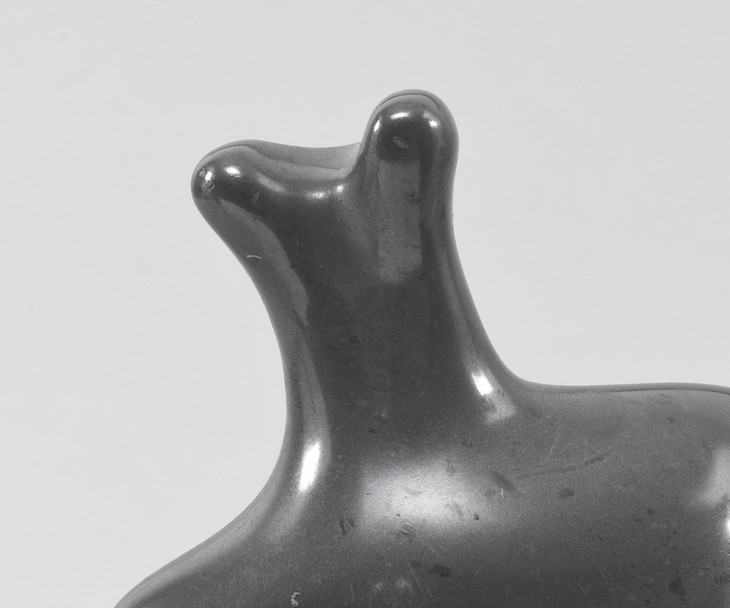
Detail of rear of head of Reclining Figure 1939
Tate T03761
© The Henry Moore Foundation. All Rights Reserved
Fig.2
Detail of rear of head of Reclining Figure 1939
Tate T03761
© The Henry Moore Foundation. All Rights Reserved
The head is u-shaped, with two curving sides suggesting the sides of the head, and a point at the front may be read as a chin (fig.1), but otherwise no facial features have been represented. Together, the head and thick tubular neck are reminiscent of an open, upward thrusting mouth, but when seen from the rear the two sides of the head are reminiscent of insect antenna (fig.2).
The neck leads down from the head to a pair of broad powerful shoulders and an arched back. The right shoulder curves downwards delineating the sculpture’s back, and there is no separate right arm. The left shoulder leads to the left arm on which the weight of the upper body is propped. The upper part of the left arm is separated from the main body of the sculpture by an oval hole. Bent at the elbow, the left forearm rests on the wooden base and merges with the side of the figure.
The breast plate projects forwards from the neck, arching over the hollowed torso with curved edges creating a loosely-shaped pair of breasts (fig.3). The left breast is pierced with a hole suggesting an areola or nipple. Although there is no separate right arm, one is subtly suggested. Following the curve of the shoulder down the side of the body, a slight ridge running from the abdomen to the hip can be discerned. This ridge is suggestive of a forearm and culminates in a mound, which could be a hand.
The curved, undulating leg section is pierced with a hole separating the two legs. Despite the schematic treatment of the limbs, it is possible to ascertain that the left leg rests on its side, bent at the knee, so that the front of the thigh faces forwards and the calf extends backwards on a diagonal. The right knee is raised so that the front of the right leg faces upwards and the right thigh creates an arch or bridge over the left. The right calf merges into the left, which is presented as a triangular wedge with a flat upper surface. When seen from the rear, the back, hips, buttocks and legs create a sequence of rounded forms and a sliver of empty space can be seen underneath the left arm and torso of the sculpture.
Although his teaching duties as Head of the Sculpture Department at the Chelsea School of Art kept him in London for much of his time, in 1935 Moore bought a cottage called Burcroft near Canterbury in Kent. In a letter dated 30 April 1939 to his friend Arthur Sale, Moore explained that ‘We go [to Burcroft] whenever we can be free from London because I can work better there’.1 It is likely that this lead sculpture was one of a number of small metal sculptures cast by Moore in a kiln constructed in his garden. This practice of ‘backyard casting’ was relatively common among artists producing small scale sculptures in the 1930s, and lead was a particularly favoured material due to its low melting point.
At Burcroft Moore employed Bernard Meadows as an assistant. Meadows was a sculpture student at Norwich School of Art and later the Royal College of Art in London, and worked for Moore during his summer vacations between 1936 and 1940. On 9 December 1987 Tate curator Judith Collins interviewed Meadows with a focus on his role in the creation of Moore’s lead sculptures. Collins’s catalogue entry notes that Meadows ‘remembers casting lead pieces during the summer months of 1938 and 1939’, and that he ‘then stayed on alone at Burcroft in the winter holidays of 1938 and 1939 working on the lead casts’.2 Collins continued:
Meadows recalled how, once Moore had decided to cast in lead, he sought technical information both from a foundry and from the local blacksmith, who encouraged him to use bellows with his kiln. The metal came from lengths of lead armature piping used at Chelsea School of Art, and Moore also decided to melt down one of his earlier lead figures, the Seated Figure of 1930. Meadows and Moore improvised a kiln in the field belonging to Burcroft, building a tunnel-like structure incorporating a domestic terracotta fireback. A fire was built in this structure, with Meadows working the bellows, and the success of this procedure depended largely on the wind direction at the time.3
In order to create the lead Reclining Figure it is likely that Moore first made a model in wax. In 1960 Moore recounted that during his experiments with backyard casting he discovered that he could skip one of the usual stages of the lost wax process by modelling directly in wax.4 Meadows recalled in 1987 that the wax used for the lead sculptures made between 1938 and 1940 was ‘beeswax, bought from Boots the Chemist’ in Canterbury.5 Having modelled the original wax sculpture it was then encased in a hard material, usually plaster mixed with an aggregate of ground-up pottery. Moore then used the lost wax technique to make the lead version, whereby the casing containing the wax was placed in the kiln and heated so that the wax could be melted out. Molten lead was then poured into the sculpture-shaped void left inside the casing. In light of her conversation with Meadows, Collins narrated that ‘the lead was melted down in a large domestic saucepan, one of Irina Moore’s, over a primus stove in the studio. The main consideration was whether the saucepan handle could withstand the weight of the lead when the saucepan was lifted and carried outside to the mould for the pouring of the molten metal’.6 When the lead had cooled and hardened, the outer casing would have been removed to reveal the sculpture inside. However, one of the disadvantages of working in wax and using this direct lost wax casting method was that since there was only one original sculpture, there was only one opportunity to cast the sculpture in metal. If any stage in the process went wrong, the sculpture would be lost. This element of risk may explain why Mary Moore, the artist’s daughter, recounted that Moore ‘thought he’d try lead casting at home, because by then he was so macho and he just thought, “Well, why can’t I do it?”’.7 However, Moore was also practical, and it seems likely that the surviving terracotta version of this sculpture was a copy of the wax original, made so that a reference copy would survive after the casting process.
It is probable that Reclining Figure was one of a number of sculptures made between August and early October 1939. In a letter to his friend the critic Herbert Read dated 9 October Moore noted:
At present and during the last few weeks I’ve been doing ideas and small figures for metal. Bernard Meadows, the student who’s helped me with roughing out and odd jobs during the last 2 or 3 summers is here with us, probably until he’s called up [to serve in the Second World War] or gets a job, because the Royal College of Art hasn’t started again – And between us we’ve cast the wax models I make, into lead. After casting they need quite a lot of working on, but in the last month out of the 8 or 9 we’ve cast, I’ve completed three or four and have just sent two for the Leicester Galleries mixed Autumn show they’re having.8
According to Collins:
Meadows remembered that the chasing of the lead figures after casting was a laborious process. Large excess shapes were removed with metal files, but then for a more delicate finish, the files have to be abandoned in favour of polishing by hand. Emery or sandpaper cannot be used because the emery works itself into the surface of the lead. Meadows knew of a carpenter who suggested that sharkskin was a very good polishing agent, so a sharkskin was obtained and used. Lead dust causes a very fine black powder to settle on the polisher’s face and hands and Meadows remembered that he often had a black face when polishing pieces like Reclining Figure 1939 (Tate T03761).
It is known that Moore cast at least sixteen lead sculptures at Burcroft between 1938 and 1940. Fourteen of these, including Reclining Figure, were exhibited at his exhibition New Sculpture and Drawings at the Leicester Galleries, which having been postponed from November 1939 took place in February 1940.
Prior to casting in lead in 1938–40 Moore had only made three other lead sculptures: Mask 1929 (formerly in the collection of Kenneth Clark), Seated Figure 1930 (destroyed) and Reclining Figure 1930 (private collection). These are believed to have been cast at a professional foundry, probably Gaskin or Fiorini, both based in London. Moore’s Reclining Figure 1939 is a unique cast in lead, although Moore later cast four bronze versions.9 Although the details regarding when and where these subsequent casts were made was not recorded, one example was accessioned into the collection of the British Council in March 1948, suggesting that the bronzes were cast some time between 1939 and 1948. In 1973 Moore explained that at the time he was making lead sculptures:
I didn’t know about lead – I didn’t know that you could put a little antimony with it and make it hard – so since then all the leads have been damaged. And they come back to me to be repaired, or to be salvaged – because in some cases if you drop a lead on the floor, on a hard floor, it will just collapse, whereas bronze is almost indestructible. So, to save the idea, I re-cast them into bronze.10
The later bronze casts of this work and other sculptures after lead originals, such as Reclining Figure 1939 (Tate T00387), would have been made at a professional bronze foundry. In order to re-cast a lead sculpture in bronze a mould would be made directly from the lead sculpture. It is known for example that Moore borrowed a lead Reclining Figure from its owner, Peter Gregory, in 1958 in order to cast an edition in bronze.11 However, it is likely that the foundry was able to recast this Reclining Figure using the surviving terracotta model.
The reclining figure propped up on its elbows with raised knees emerged as a central motif in Moore’s work during the late 1920s. Moore carved his first reclining figure around 1924 but took up the subject with greater seriousness in 1929 and it became his most frequently recurring subject. In 1947 Moore accounted for his preference for the reclining figure, stating:
There are three fundamental poses of the human figure. One is standing, the other is seated, and the third is lying down ... But of the three poses, the reclining figure gives most freedom compositionally and spatially. The seated figure has to have something to sit on. You can’t free it from its pedestal. A reclining figure can recline on any surface. It is free and stable at the same time. It fits in with my belief that sculpture should be permanent, should last for eternity. Also, it has repose, it suits me – if you know what I mean.12
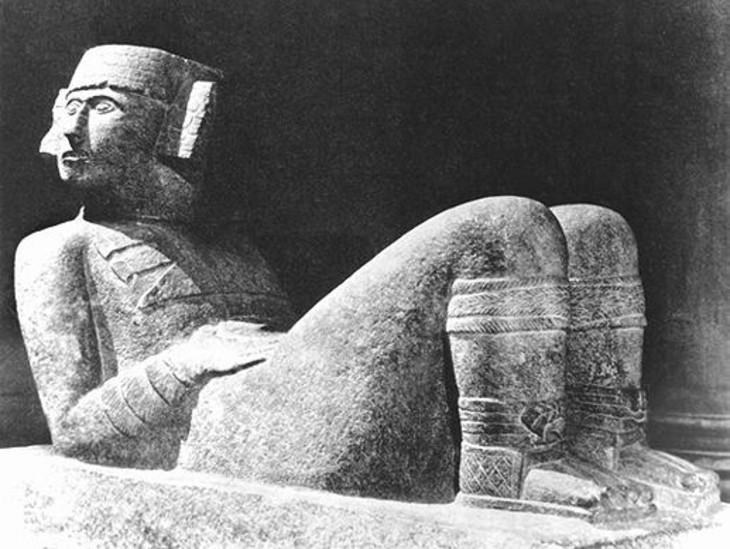
Toltec-Mayan sculpture of Chacmool from Chichén Itzá, c.900–1000
Limestone
1050 x 1480 mm
Museo Nacional de Antroplogia, Mexico City
Fig.4
Toltec-Mayan sculpture of Chacmool from Chichén Itzá, c.900–1000
Museo Nacional de Antroplogia, Mexico City
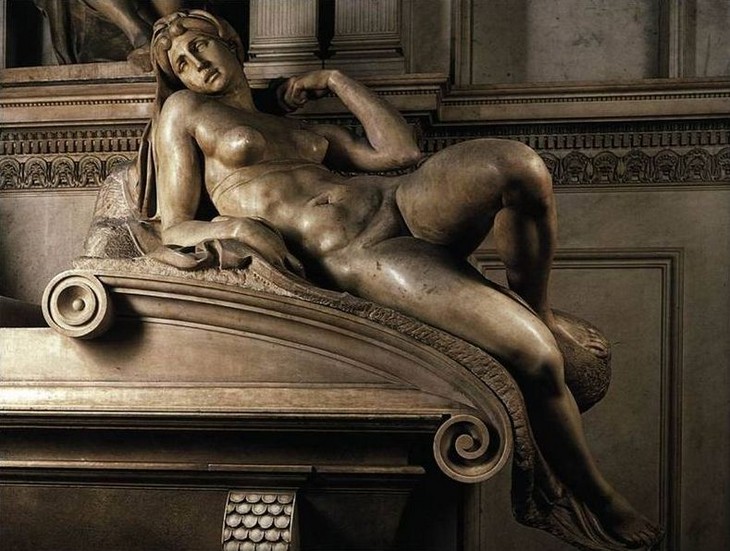
Michelangelo
Dawn c.1520–34
Medici Chapel, Basilica of San Lorenzo, Florence
Fig.5
Michelangelo
Dawn c.1520–34
Medici Chapel, Basilica of San Lorenzo, Florence
The origins of Moore’s fascination with the subject of the reclining figure cannot be pinpointed to a single definitive source. For example, in the catalogue to Moore’s 1968 exhibition at the Tate Gallery, images of a reclining Chacmool, a rain spirit of the ancient Toltec-Mayan culture (fig.4), and Michelangelo’s carvings of allegorical figures in the Medici Chapel in Florence were reproduced under the heading ‘comparative material’. However, the author of the catalogue, the critic David Sylvester, noted that prior to Moore’s trip to Italy in the early 1920s Moore had only made one (male) reclining figure, and that the subject only took hold of Moore’s imagination upon his return. Central to Sylvester’s argument was the importance of Michelangelo’s work, in particular the sculpture Dawn c.1520 (fig.5). Sylvester argued that even when Moore’s figures became more abstract they nonetheless had ‘poses which are the perogative of the Mediterranean tradition’.13
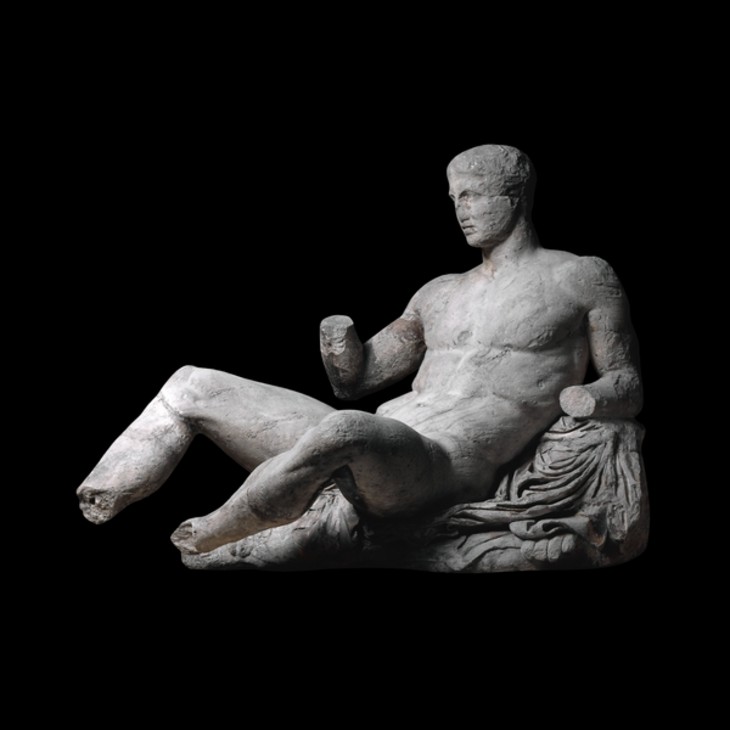
Figure of Dionysos from the east pediment of the Parthenon c.438–432 BC
British Museum, London
© Trustees of the British Museum
Fig.6
Figure of Dionysos from the east pediment of the Parthenon c.438–432 BC
British Museum, London
© Trustees of the British Museum
By choosing the subject of the reclining female figure for his sculptures, Moore was free to experiment with sculptural forms, both compositionally (in the position of the body and its limbs) and spatially (in the ways in which the figure’s limbs projected into space and interacted with spatial gaps). In addition to these perceived virtues, Moore also believed that because the subject of the reclining figure was known and understood, he was not tied to creating naturalistic artworks. On the subject of his reclining figures Moore was clear that he did not seek to imbue his sculptures with a specific meaning, but rather to use the motif as a starting point for formal experiments:
I want to be quite free of having to find a ‘reason’ for doing the Reclining Figures, and freer still of having to find a ‘meaning’ for them. The vital thing for an artist is to have a subject that allows [him] to try out all kinds of formal ideas – things that he doesn’t yet know about for certain but wants to experiment with, as Cézanne did in this ‘Bathers’ series. In my case the reclining figure provides chances of that sort. The subject-matter is given. It’s settled for you, and you know it and like it, so that within it, within the subject that you’ve done a dozen times before, you are free to invent a completely new form-idea.17
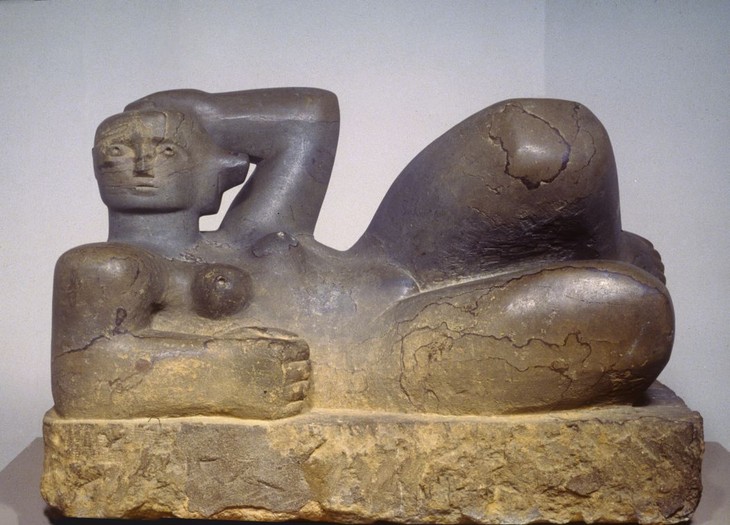
Henry Moore
Reclining Figure 1929
Brown Hornton stone
Leeds City Art Gallery
© The Henry Moore Foundation. All Rights Reserved
Fig.7
Henry Moore
Reclining Figure 1929
Leeds City Art Gallery
© The Henry Moore Foundation. All Rights Reserved
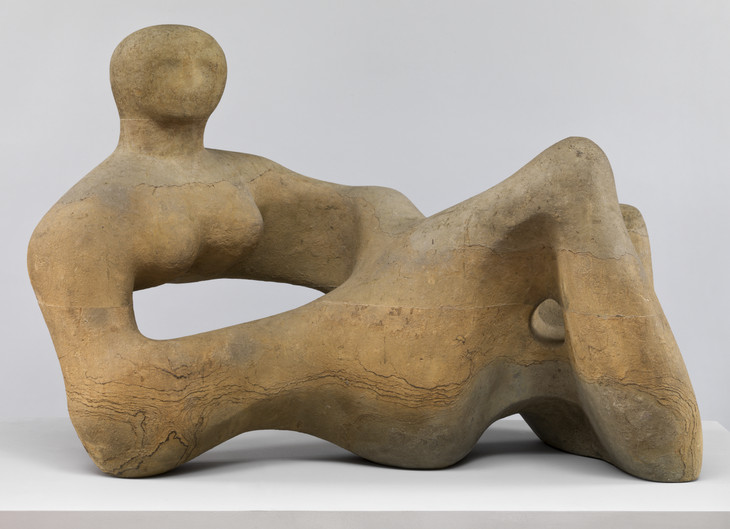
Henry Moore OM, CH 1898–1986
Recumbent Figure 1938
Green Hornton stone
object: 889 x 1327 x 737 mm, 520 kg
Tate N05387
Presented by the Contemporary Art Society 1939
© The Henry Moore Foundation. All Rights Reserved
Fig.8
Henry Moore OM, CH
Recumbent Figure 1938
Tate N05387
© The Henry Moore Foundation. All Rights Reserved
Reclining Figure may be understood as a development of Moore’s earlier Reclining Figure 1929 (fig.7) and Recumbent Figure 1938 (fig.8), which were carved in Brown and Green Hornton stone respectively. Like Reclining Figure both of these earlier sculptures present a female figure lying down with her belly and legs extending from her upright head and shoulders. In all three sculptures the figure rests on an elbow – on the right elbow in the two earlier works and on the left elbow in the 1939 lead sculpture – and her knees are bent. All three have rounded projecting breasts. In the later lead work, however, Moore dispensed with the heavy block-like composition of the 1929 sculpture and accentuated the holes and pierced shapes seen in Recumbent Figure in order to give the 1939 sculpture a sense of movement and fluidity, characteristics which are enhanced by its smoothed polished surfaces.
Moore’s desire to open out the sculpture through the use of holes had presented technical problems when working in stone and wood that were only resolved by his turn to metal casting in 1937–8. Working in wax or plasticine enabled Moore to create pierced and more thinner forms than were possible in stone, and he observed in 1960 that working in this way allowed sculptors to make ‘spatial forms’.18 Reflecting on Moore’s changing forms and materials, Sylvester noted that ‘lead has a mechanistic sleekness, and Moore has exploited this in sculptures possessing so much open space, and so little solid mass, that they are skeletons rather than bodies, scaffoldings rather than buildings. Hence, the eye pursues at speed their rhythms and their hard contrasts of light and shadow.’19
The fluid shapes of Reclining Figure may also have been conceived in response to the trend for elastic, gelatinous forms already prevalent in Europe by the early 1930s. In 1935 the critic Geoffrey Grigson had used the term ‘biomorphic’ to describe a type of art that suggested an organic quality or drew upon memories of naturally occurring forms such as pebbles and bones.20 And by 1936 the curator Alfred H. Barr had ‘identified biomorphic abstraction as the most significant new development in international abstract art, and named Moore as its paradigmatic representative’.21
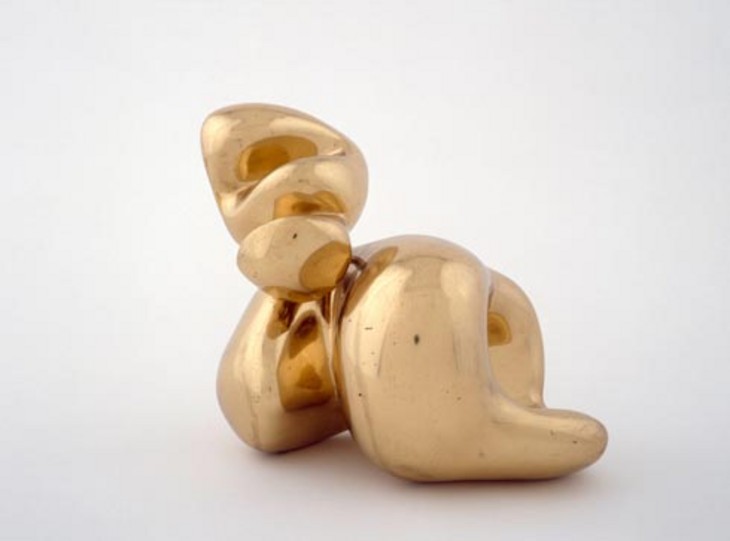
Jean Arp
Head and Shell c.1933
Polished brass
197 x 225 mm
Peggy Guggenheim Collection, Venice
© Artists Rights Society (ARS), New York / VG Bild-Kunst Bonn
Photo: David Heald © SRGF
Fig.9
Jean Arp
Head and Shell c.1933
Peggy Guggenheim Collection, Venice
© Artists Rights Society (ARS), New York / VG Bild-Kunst Bonn
Photo: David Heald © SRGF
signifies the material process of condensation, hardening, coagulating, thickening, growing together. Concretion designates the solidification of a mass. Concretion designates curdling, the curdling of the earth and the heavenly bodies. Concretion designates solidification, the mass of the stone, the plant, the animal, the man. Concretion is something that has grown.23
In 1970 the art critic Robert Melville observed that ‘during the period from 1931 to the beginning of the war, Moore carved a superb series of organic abstractions. They are as “shape conscious” as the sculpture of ... Arp, but they are more persistently penetrated by human associations’. 24 For Melville, Moore’s apparent engagement with Arp revealed ‘his connections with Surrealism. He belongs to the Surrealist generation’.25 The inclusion of an illustration of Arp’s Human Concretion 1933 under the heading ‘comparative material’ in Moore’s 1968 catalogue would seem to support Melville’s proposition that he had indeed been influenced in some way by the work of the French sculptor, while the art critic John Russell proposed more emphatically that instead of merely replicating Arp’s work, Moore’s sculptures reflected ‘a wish to adapt the formal language of Arp to purely human preoccupations’.26 Indeed, in 1937, Moore wrote:
rounded forms convey an idea of fruitfulness, maturity, probably because of the earth, woman’s breast’s, and most fruits are rounded, and these shapes are important because they have this background in our habits of perception. I think the humanist organic element will always be for me of fundamental importance in sculpture, giving sculpture its vitality ... My sculpture is becoming less representational, less an outward visual copy, and so what people would call more abstract; but only because I believe that in this way I can present the human psychological content of my work with the greatest directness and intensity.27
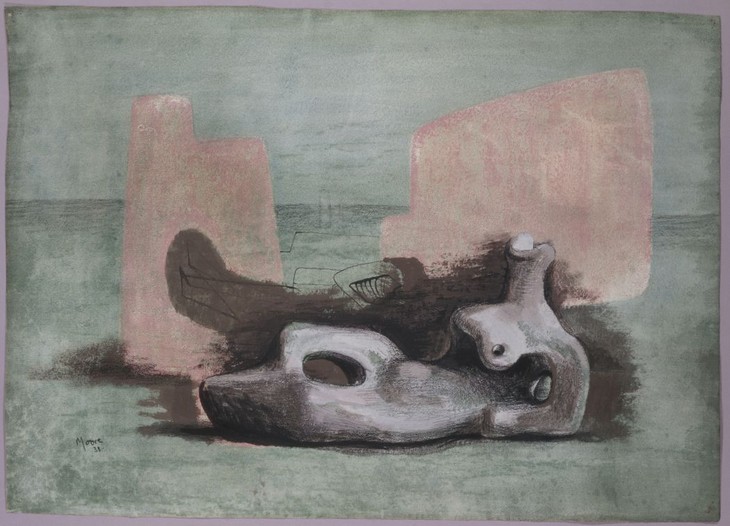
Henry Moore
Reclining Figure with Red Rocks 1938
Graphite, wax crayon, pastel, charcoal, watercolour, gouache, pen and ink on paper
385 x 553 mm
Private collection
© The Henry Moore Foundation. All Rights Reserved
Fig.10
Henry Moore
Reclining Figure with Red Rocks 1938
Private collection
© The Henry Moore Foundation. All Rights Reserved
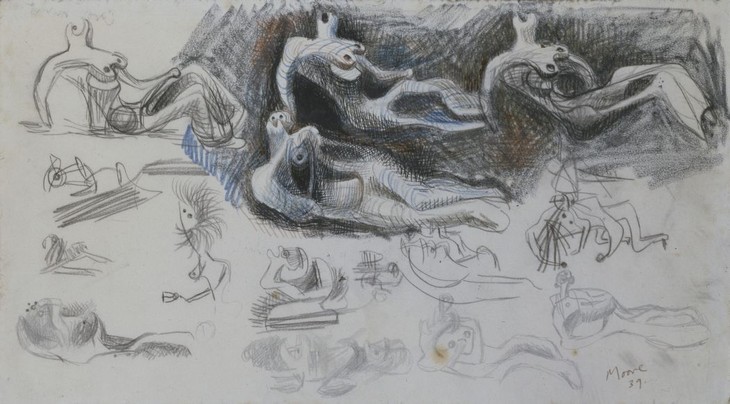
Henry Moore
Ideas for Metal Sculpture: Reclining Figures 1939
Graphite, crayon, chalk, pen and ink on paper
Private collection
© The Henry Moore Foundation. All Rights Reserved
Fig.11
Henry Moore
Ideas for Metal Sculpture: Reclining Figures 1939
Private collection
© The Henry Moore Foundation. All Rights Reserved
Although Moore had made piercings in his stone sculptures from as early as 1928, it was not until the early 1930s that he recognised the potential of holes in sculpture. In 1937 Moore articulated his appreciation of holes in his article ‘A Sculptor Speaks’, published in the Listener:
Pebbles show nature’s way of working stone. Some of the pebbles I pick up have holes right through them ... A piece of stone can have a hole through it and not be weakened – if the hole is of a studied size, shape and direction. On the principle of the arch, it can remain just as strong. The first hole made through a piece of stone is a revelation. The hole connects one side to another, making it immediately more three-dimensional. A hole can have as much shape-meaning as a solid mass. Sculpture in air is possible, where the stone contains only the hole, which is the intended and considered form. The mystery of the hole – the mysterious fascination of caves in hillsides and cliffs.32
In Reclining Figure with Red Rocks the arch created by the right leg both complements and is complemented by the standing rocks in the background, so that the forms of the human body seem at one with the surrounding environment. Indeed, Friedman suggested that Reclining Figure ‘like its many related sculptures by Moore, is both human and geological, both figure and landscape’.33
Looking back at his time in Kent Moore identified this period as the moment when his interest in the relationship between sculpture and the natural environment became a major preoccupation:
Living at Burcroft was what probably clinched my interest in trying to make sculpture and nature enhance each other. I feel that the sky and nature are the best setting for my sculpture. They are asymmetrical, unlike an architectural background with its verticals and horizontals. In a natural setting, the background to a sculpture changes if you move only a very small distance.34
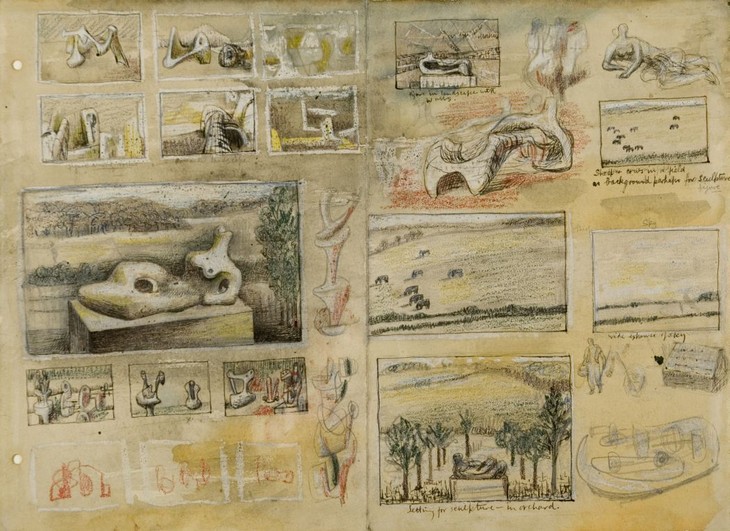
Henry Moore
Ideas for Sculpture in Landscape c.1938
Graphite, wax crayon, watercolour, pen and ink on paper
277 x 381 mm
© The Henry Moore Foundation. All Rights Reserved
Photo: Michael Phipps, Henry Moore Foundation Archive
Fig.12
Henry Moore
Ideas for Sculpture in Landscape c.1938
© The Henry Moore Foundation. All Rights Reserved
Photo: Michael Phipps, Henry Moore Foundation Archive
Reclining Figure was exhibited at Moore’s exhibition New Sculpture and Drawings at the Leicester Galleries, London, in February 1940. In a memo dated 8 February 1940 written to Leigh Ashton, Director of the Victoria and Albert Museum (V&A), the secretary of the museum wrote:
There is a private view to-day at the Leicester Galleries of recent sculpture by Henry Moore; whom many people would regard as the most important of the younger generation of English sculptors, a view which I certainly hold myself. Mr. Bedford went yesterday before the show was open and asked the proprietors of the Gallery, with who we are on very good terms, to reserve one of the small lead figures with a view to its possible purchase for the Department of Circulation; and I went to the Gallery myself early this afternoon and I quite agree with him that the figure is, on the whole, the best of the lead figures there exhibited ... an example of Henry Moore’s work like this would be of great value and I hope very much that you will agree to its being purchased.38
The sculpture was duly purchased by the V&A for the sum of £40 on 29 February 1940. On entering the museum’s collection the sculpture was placed in the Department of Circulation, then under the direction of Mr Bedford. The department’s remit was to make works of art available to art schools and regional galleries so that students could view exemplary examples of art without having to travel to London. The Department of Circulation had its own specific collection designed to meet these needs and curated complete exhibitions, which included interpretative literature, that travelled around the country. It is likely that Reclining Figure was included in the exhibitions Twentieth-Century Sculpture, which toured between 1953 and 1963, and Modern Sculpture and Sculptors’ Drawings, which toured between 1967 and 1972.39
In 1983 Reclining Figure was one of seventy twentieth-century sculptures transferred from the V&A to the Tate Gallery. The transfer was made in order to rationalise the collections of both institutions, and was reciprocated by the Tate, which transferred to the V&A six of the earliest sculptures in its collection. When Reclining Figure entered the Tate collection it was noted that the V&A’s acquisition number ‘CIRC. 17–1940’ was written in white ink on the underside of the sculpture.
Alice Correia
January 2013
Notes
Henry Moore, letter to Arthur Sale, 30 April 1939, Imperial War Museum Archive, IMW/ART/16597/1. For a transcript of the letter see http://www.iwm.org.uk/collections/item/object/19443 , accessed 11 June 2013.
[Judith Collins], ‘Henry Moore: Reclining Figure 1939’, in The Tate Gallery 1984–86: Illustrated Catalogue of Acquisitions Including Supplement to Catalogue of Acquisitions 1982–84, London 1988, p.539.
Henry Moore cited in Donald Hall, ‘Henry Moore: An Interview by Donald Hall’, Horizon, November 1960, reprinted in Alan Wilkinson (ed.), Henry Moore: Writings and Conversations, Aldershot 2002, p.232.
Mary Moore, ‘Reclining Figure 1939’, in Gregor Muir (ed.), Henry Moore: Ideas for Sculpture, exhibition catalogue, Hauser & Wirth, London 2010, p.137.
Henry Moore, letter to Herbert Read, 9 October 1939, Herbert Read Archive, University of Victoria. (A copy of this letter is held in the Henry Moore Foundation Archive). According to the Leicester Galleries catalogue for the autumn 1939 group exhibition Moore exhibited a lead stringed figure and a coloured chalk drawing. See Autumn Exhibitions. Selected Paintings, Drawings and Pottery Lent by the Contemporary Art Society: Paintings and Sculpture for Sale by Modern British Artists, exhibition catalogue, Leicester Galleries, London 1939, no.49 and no.137 respectively.
Two of these bronze casts are in the collection of the British Council. In 1991 a third example held in the British Council collection was acquired by exchange by the Henry Moore Foundation, where it remains. The fourth bronze cast is held in the Henry Moore Family Collection. These bronze examples have no inscriptions and it is unknown when or where they were cast.
Henry Moore cited in Donald Carroll, The Donald Carroll Interviews, London 1973, p.42, reprinted in Wilkinson 2002, p.235.
Henry Moore, letter to H.R. Fisher, 18 July 1958, Henry Moore Foundation Archive. Gregory’s lead sculpture is no.203 in the artist’s catalogue raisionné; see David Sylvester (ed.), Henry Moore. Volume 1: Complete Sculpture 1921–48, London 1957, p.115. The sculpture was cast in an edition of three bronzes, one of which is in the British Council collection, http://collection.britishcouncil.org/collection/artist/5/18427/object/43358/0 , accessed 29 January 2013.
Henry Moore cited in J.D. Morse, ‘Henry Moore Comes to America’, Magazine of Art, vol.40, no.3, March 1947, pp.97–101, reprinted in Philip James (ed.), Henry Moore on Sculpture, London 1966, p.264.
Terry Friedman, ‘Reclining Figure 1939’, in David Mitchinson (ed.), Celebrating Moore: Works from the Collection of the Henry Moore Foundation, London 2006, pp.177–8.
A.D.B. Sylvester, ‘The Evolution of Henry Moore’s Sculpture: I’, Burlington Magazine, vol.90, no.543, June 1948, p.164.
Geoffrey Grigson, ‘A Comment on England’, Axis, no.1, January 1935, p.10. For a discussion of Grigson’s use of the term ‘biomorphic’ see Jennifer Mundy, ‘Comment on England’, in Chris Stephens (ed.), Henry Moore, exhibition catalogue, Tate Britain, London 2010, pp.22–37.
Christopher Green, ‘Henry Moore and Picasso’, in James Beechy and Chris Stephens (eds.), Picasso and Modern British Art, exhibition catalogue, Tate Britain, London 2012, p.139.
Henry Moore, ‘A Sculptor Speaks’, Listener, 18 August 1937, pp.338–40, reprinted in Wilkinson 2002, p.195.
Henry Moore cited in Henry Moore, exhibition catalogue, Arts Centre, Folkestone 1983, reprinted in Wilkinson 2002, p.59.
A photograph of Moore’s lead Reclining Figure 1938 (Museum of Modern Art, New York) taken around the time it was made shows the small sculpture against the skyline at Burcroft. The angle at which the photograph was taken makes the sculpture appear far larger than it is, and in 1978 Moore stated his intention to enlarge the sculpture and position it on a small man-made hill at the end of the sheep field adjacent to his home in Hertfordshire. In 1984 the sculpture was indeed enlarged, and was installed on the hill posthumously.
Secretary, Memo to the Director, 8 February 1940, Victoria & Albert Museum Archive, Ernest Brown and Phillips Limited File, MA/1/BB819/3.
See Victoria & Albert Museum Archive, School Loans Prospectuses MA/17/1; Travelling Exhibitions Available for Loan to Public Museums, Art Galleries and Public Libraries Prospectuses, MA/17/2; Exhibitions for Loan to Museums, Art Galleries and Libraries Prospectuses, MA/17/3/4; and Exhibitions for Loan to Museums, Art Galleries and Libraries Prospectuses, MA/17/5.
Related essays
- Henry Moore and the Values of Business Alex J. Taylor
- Life Forms: Henry Moore, Morphology and Biologism in the Interwar Years Edward Juler
- Erich Neumann on Henry Moore: Public Sculpture and the Collective Unconscious Tim Martin
- Henry Moore's Approach to Bronze Lyndsey Morgan and Rozemarijn van der Molen
Related catalogue entries
Related material
How to cite
Alice Correia, ‘Reclining Figure 1939 by Henry Moore OM, CH’, catalogue entry, January 2013, in Henry Moore: Sculptural Process and Public Identity, Tate Research Publication, 2015, https://www

